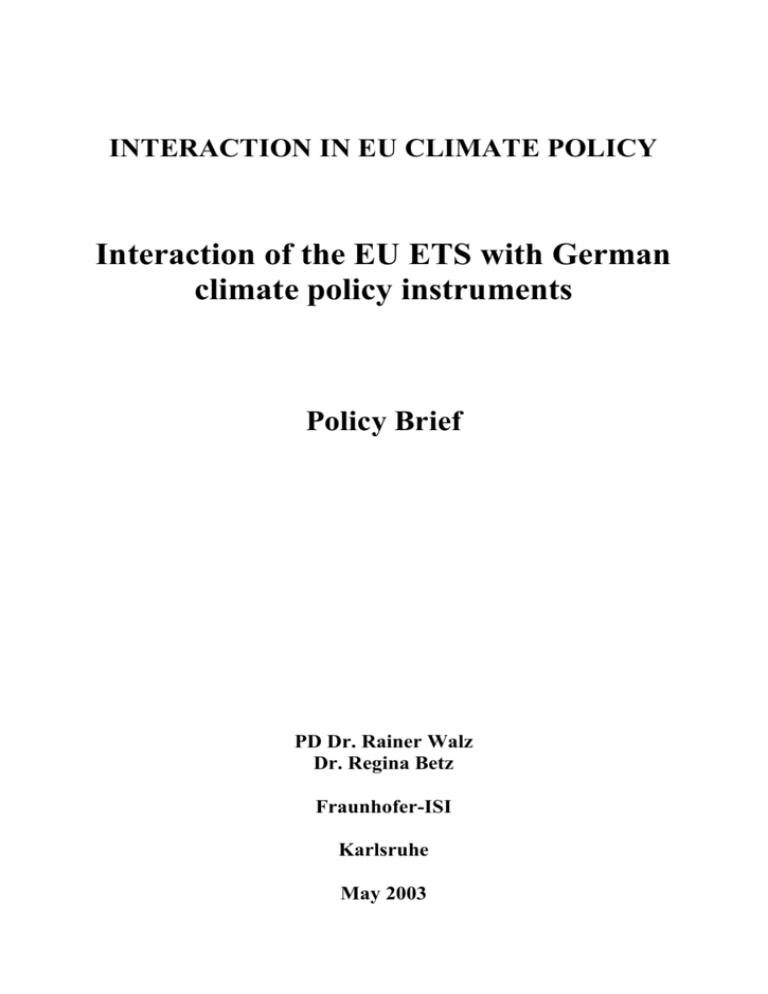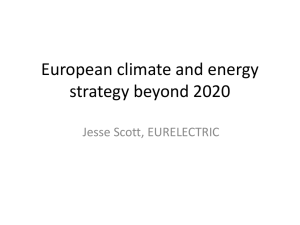Interaction between the EU-ETS and the Renewable Energy Act
advertisement

INTERACTION IN EU CLIMATE POLICY Interaction of the EU ETS with German climate policy instruments Policy Brief PD Dr. Rainer Walz Dr. Regina Betz Fraunhofer-ISI Karlsruhe May 2003 Introduction This policy brief presents an overview of the implications of the proposed EU Emissions Trading Scheme (EU ETS) for some selected energy and climate policy instruments in Germany. It summarises the results of research that has been conducted by the Fraunhofer Institute for Systems and Innovation Research (ISI), as part of the INTERACT project. Within the INTERACT project, the interaction between the proposed EU ETS and the following three German climate policy instruments was analysed: Voluntary Agreements tackling Climate Change (CCA), the Eco Tax, and the Renewable Energy Act (REA). In each case, an initial interaction analysis has been performed according to the methodology set out in the INTERACT project. Based on the analysis of interactions between the EU ETS and the existing instruments, an analysis of implementation options has been performed in order to reveal institutional arrangements which can significantly change the outcome of the interaction. The interaction is evaluated using criteria such as environmental effectiveness, (static and dynamic) economic efficiency, administrative simplicity, and equity. Interaction between the EU ETS and Climate Change Agreements Voluntary agreements play a prominent role in Germany for the industrial sector. The first agreements tackling Climate Change were made by industrial associations in 1995 and 1996 and renewed in 2001. In addition to the interaction analysis under existing instrument arrangements, two implementation options have been developed: Implementation Option 1: Replacing voluntary agreements, but building on them by adopting their targets as a basis for allocation. Implementation Option 2: Pooling activities under the EU ETS, whereby the pools could be mandatory or voluntary. This option was introduced by the German government in the negotiations of the EU ETS. As they are currently proposed, the EU ETS and the CCAs a pair very unlikely to operate in parallel, since this would result in an acceptable double-regulation. Furthermore, there are incompatibilities arising from incentive setting and sanctions. Compared to interaction under existing arrangements, both Implementation Option 1 and 2 leads to a lower environmental effectiveness. Implementation Option 1, which is based on the targets of the CCA, is much more realistic than the introduction of mandatory pools as described under Implementation Option 2. Voluntary pools might have a chance only if the costs for negotiating the allocation for single installations are assumed to be higher than the benefits from selling allowances. Interaction between the EU ETS and the Eco Tax The analysis of EU ETS and the Eco Tax covers the interaction for the instruments as a pair under arrangements before 2003 and for three implementation options: Implementation Option 1, which has been implemented in 2003, increases the tax rate for industry and designs a new preferential treatment of very energy-intensive companies. Implementation Option 2 is designed to reduce double regulation and exempts EU ETSinstallations from the Eco Tax. Implementation Option 3 aims to achieve a greater equivalence of effort within industry. A number of design variables are altered for this implementation option, especially changing the tax box of the Eco Tax and linking the tax rate to the results of emissions trading. The results of the different cases revealed the following picture: The interaction under instrument arrangements before and since 2003 (Implementation Option 1) lead to double regulation. Double regulation at the installation level is phased out in Implementation Options 2 and 3. However, at an institutional level, the operators of installations remain subject to the Eco Tax for non ETS-installations. Summing up the different effects on environmental effectiveness, Implementation Option 2 and 3 seem to reduce the stringency of the policy. With the exception of Implementation Option 3, all cases result in different marginal costs within industry. Despite the double regulation of the instruments (interaction under existing arrangements before and since 2003), it can even be argued that, due to the interaction, the marginal costs of EU ETS installations might approach those of the remaining sectors which are subject to the Eco Tax only. All cases may lead to problems of equity. However, no clear picture emerges for the effects within industry. Implementation Option 2 and 3 would lead to several difficulties in implementation. In addition to CO2 reduction, the Eco Tax can be justified through additional environmental policy goals. Furthermore, the Eco Tax is justified through the objective of raising money to lower the cost of labour in order to increase employment. Interaction between the EU-ETS and the Renewable Energy Act The analysis of EU ETS and the Renewable Energy Act (REA) covers the interaction for the instruments as a pair under existing arrangements and three implementation options: In Implementation Option 1, a provision is analysed that an investment in RES from an ETS participant would lead to a cancellation of allowances. In Implementation Option 2, the feed-in prices are reduced for investors who are participants in the ETS. In Implementation Option 3, the feed-in prices for all investors are reduced. The following results of the interaction analysis are especially important: The greatest environmental effectiveness is achieved in the interaction under existing instrument arrangements. The evaluation of the static economic efficiency depends whether or not the avoided costs of the reduction in non-GHG emissions are taken into account. If only internal costs are considered, a shift towards RES generally increases the marginal costs. Thus, interaction under existing instrument arrangements would have the lowest static efficiency. If the ancillary environmental benefits of RES are monetised, however, interaction under existing arrangements might be even more efficient than Implementation Option 3. It can be argued that the interaction under existing arrangements is likely to improve the dynamic efficiency for RES because it seems to combine a strong incentive to establish market niches and direct learning processes with a strong incentive to create a mass market and to bring in the additional resources of the utilities to exploit the market. All three implementation options make the implementation of the instruments more complex and increase administrative costs. To a certain extent, the political acceptability mirrors the conflicts often seen in environmental policy: the interest of environmental groups together with an evolving industry of rather small and new enterprises are up against the interest of the incumbents consisting of well established and larger enterprises. Within industry, the acceptability depends on the specific equity effects. To a certain extent, the overall evaluation of the different options indicates a trade-off between static economic efficiency on the one hand (if the external costs of ancillary benefits and transactions costs are not taken into account) and environmental effectiveness, administrative simplicity, and perhaps dynamic efficiency on the other hand. In addition to CO2 reduction alone, the Renewable Policy act can be justified through additional policy goals, such as reduction in air pollutants, or less dependence on nonrenewable resources. Policy Conclusions Different policy conclusions can be drawn from the analysis. The following aspects are relevant in a short term perspective: The political economy of climate change suggests that Implementation Option 1 of the interaction between EU ETS and CCA (adopting CCA targets as a basis for allocation) might be attractive. However, there are some difficulties in implementation. For the interaction between EU ETS and Eco Tax, Implementation Option 1 (higher tax rates with less pronounced preferential treatment) seems to be the preferred short-term option, especially as long as there are relative weak targets within the allocation plan. For the interaction between EU ETS and REA, the instruments interacting under existing arrangements could be a likely outcome. Otherwise, there would be a need for a separate strong policy to ensure the political target of doubling RES. In the long run, however, different conclusions might prevail. The following perspectives might evolve for policy making, especially if the different interaction options are looked at simultaneously: If strict targets are set within the allocation plan, a tax exemption or reduced eco tax rates for EU-ETS installations could be an interesting option. Strict targets in the allocation plan could be derived by using a Best Available Technology (BAT) benchmark approach. In that case, Implementation Option 3 of the interaction between EU ETS and Eco Tax would be an interesting policy. The future of REA depends on both the development of RES and the political weight of the target of increasing renewable energy. If the development of the RES industries is judged to be beyond the early stages, a change towards green electricity certificates could be discussed. However, for the development of RES the dynamic efficiency plays a pivotal role. Thus, changes in the incentive system for RES should be based on a thorough analysis of the innovation systems of RES. Besides these policy making conclusions, the interaction analysis between the Eco Tax and the Directive also revealed certain interesting aspects relevant for policy making in general: The results of the interaction analysis depend on many aspects, such as stringency of targets, outcome of the allocation plan, or even details as the provisions for cancellation of allowances. There are many trade-offs in evaluation, not only between environment, efficiency, and equity, but even between static and dynamic efficiency. In order to derive policy conclusions, it is necessary to weigh the different criteria against each other. Equivalence of effort is difficult to assess; and can even be improved by double regulation. Aiming at high or beneficial interaction seems to require higher levels of fine tuning of policies. This can be interpreted as a trade-off between high interaction and feasibility of policy making. Finally, the cases analysed clearly demonstrate that there are different policy objectives within energy and climate policy. Besides the reduction of greenhouse gases, objectives such as reducing the use of fossil fuels, increasing in renewable energy, or changing the tax base in order to reduce the cost for labour all play a significant role. Thus, increasing interaction is not a target per se. The existence of parallel instruments, even if they lack substantial interaction, should also be evaluated in light of the different objectives they are designed to meet. The introduction of trading instruments is not an incremental policy innovation, but rather a change in policy paradigm. The interaction analysis also reveals certain insights into the problems of such a substantial policy innovation. New, innovative instruments such as emissions trading have to be introduced in addition to existing instruments which interact with the new instrument. Thus, the new instrument has to be adapted to the pre-existing institutional and instrumental context. There is a certain path dependency of policy making, which constrains the implementation of new instruments, and which makes it necessary to search for transition strategies. Perhaps the approach of innovation systems and the debate on transition management of large technological systems – e.g. the creation of niches to facilitate a change in trajectories – could give some interesting insights for the future analysis of policy instrument innovations. Further reading Walz, R. and R. Betz (2003), Interaction of the EU ETS with German climate policy instruments, FhISI, Karlsruhe, Germany, available from: http://www.sussex.ac.uk/spru/environment/research/interact.html.







